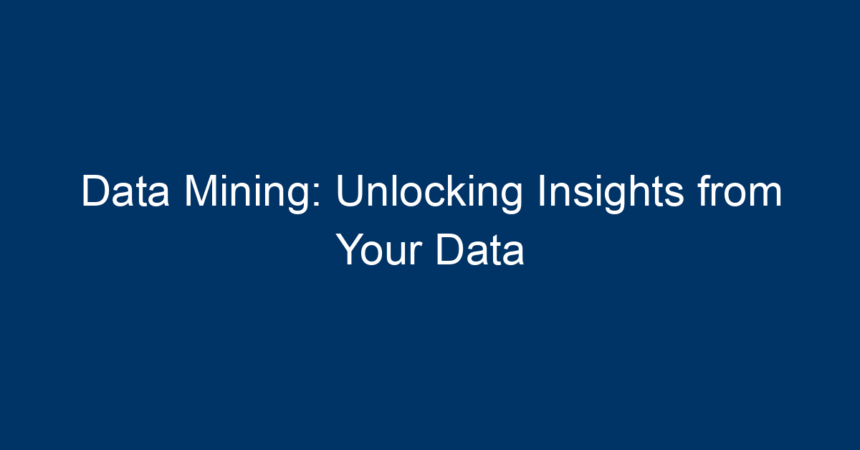In today’s data-driven world, businesses generate and collect an unprecedented amount of data every day. This wealth of information can be daunting, but it also presents an incredible opportunity. By leveraging data mining, organizations can uncover hidden patterns and insights that can drive decision-making, enhance customer experiences, and ultimately boost profitability. In this article, we’ll delve into what data mining is, its techniques, applications, and how you can implement it to unlock the full potential of your data.
What is Data Mining?
At its core, data mining is the process of analyzing large datasets to discover patterns, correlations, and trends that can be useful for decision-making. It involves transforming raw data into meaningful information through the use of sophisticated algorithms and statistical models.
The Importance of Data Mining
Data mining plays a significant role in various sectors, including healthcare, finance, marketing, and e-commerce. It helps businesses make informed decisions based on empirical evidence rather than mere intuition. By tapping into the potential of data mining, organizations can:
- Enhance customer segmentation
- Improve product recommendations
- Identify potential risks and fraud
- Optimize operations and processes
Techniques Used in Data Mining
Different techniques are employed in data mining, each serving distinct purposes:
1. Classification
Classification involves categorizing data into predefined classes or groups. For instance, an e-commerce platform might categorize customers into “regular,” “occasional,” or “one-time buyers” based on their purchase history. Algorithms like decision trees and logistic regression are commonly used for classification tasks.
2. Clustering
Clustering is a technique used to group similar data points without predefined categories. This can help identify natural groupings in the data. For instance, businesses can cluster customers based on purchasing behavior to tailor marketing strategies accordingly.
3. Association Rule Learning
This technique focuses on finding interesting relationships between variables in large databases. A common example is market basket analysis, where retailers can identify items that are frequently purchased together, such as chips and salsa.
4. Regression Analysis
Regression analysis is utilized to understand relationships between variables. For example, businesses can model the relationship between marketing spend and sales revenue to forecast future sales.
5. Anomaly Detection
Anomaly detection identifies rare items, events, or observations that raise suspicions by differing significantly from the majority of the data. This is especially important in fraud detection and network security.
Applications of Data Mining
The versatility of data mining techniques allows them to be applied across various industries:
In Healthcare
Data mining helps healthcare professionals analyze patient data for better treatment plans, identify potential outbreaks, and even predict hospital readmission rates.
In Finance
Financial institutions utilize data mining for credit scoring, risk management, and fraud detection. Machine learning algorithms can analyze transaction records in real time to flag suspicious activities.
In Marketing
Businesses can enhance their marketing strategies by using data mining to analyze customer behavior, segment their audience, and predict trends. This allows for more targeted marketing campaigns, ultimately leading to higher customer engagement and retention.
In E-commerce
E-commerce companies leverage data mining for product recommendations based on customer preferences and past purchases. This personalized approach enhances the shopping experience and drives sales.
In Telecommunications
Telecom companies analyze call data records to improve customer service, reduce churn, and detect fraudulent activities.
Challenges in Data Mining
While data mining offers numerous benefits, organizations also face challenges:
Data Quality
The accuracy of insights gained from data mining heavily relies on the quality of the data. Inconsistent, incomplete, or outdated data can lead to flawed analyses and poor decision-making.
Privacy Concerns
As businesses collect more personal data, concerns about privacy and data protection arise. It’s crucial to ensure compliance with regulations, such as GDPR, to protect user data.
Skill Gap
The demand for skilled data scientists and analysts who understand complex data mining techniques is high. Organizations may struggle to find qualified professionals to implement data mining strategies effectively.
Implementing Data Mining in Your Organization
To successfully harness the power of data mining, consider the following steps:
1. Define Your Objectives
Clearly outline what you hope to achieve through data mining. Whether it’s improving customer satisfaction, increasing sales, or identifying inefficiencies, a clear objective will guide your data mining efforts.
2. Gather and Prepare Your Data
Collect relevant data from various sources, ensuring that it is clean, consistent, and organized for analysis. This may involve data cleansing and transformation processes to enhance quality.
3. Choose the Right Tools
There are various data mining tools available, ranging from open-source platforms like R and Python to commercial software like RapidMiner and SAS. Choose a tool that fits your organization’s needs and expertise.
4. Apply Data Mining Techniques
Utilize the data mining techniques that align with your objectives. Experiment with multiple techniques to contrast the outcomes and choose the best approach.
5. Analyze Results and Make Decisions
Interpret the results of your data mining efforts. Share insights with stakeholders and use the findings to guide strategic decisions.
6. Monitor and Improve
Data mining is an ongoing process. Continuously monitor the results of your strategies and make adjustments as necessary for improvement.
Conclusion: Unlock the Power of Your Data
In an era where data is abundant, data mining stands out as a critical process for transforming raw data into valuable insights. By understanding its techniques and applications, organizations can unlock the potential of their data, ultimately leading to informed decision-making and improved business outcomes.
To effectively implement data mining, define clear objectives, gather and prepare quality data, choose appropriate tools, and apply relevant techniques. Monitor your results, assess their impact, and be ready to adapt your strategies.
By harnessing the power of data mining, you can ensure your organization stays ahead of the curve, making the most of every piece of data at its disposal. Whether in healthcare, finance, marketing, or beyond, the ability to unlock insights from your data can set your business apart in an increasingly competitive landscape. So, embrace data mining, and watch your insights come to life!




